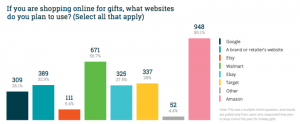There are lots of ways to create an editorial calendar, and I’m not here to tell you that my way is best. The best editorial calendar is the one you will use!
But if you have created an editorial calendar in the past and it didn’t work for you, or you rarely (OK, never) use it, consider this your troubleshooting guide.
Problem: No Focus
Solution: Know your why.
In my experience, the biggest reason an editorial calendar — or a blog for that matter — fails is that it lacks focus.
Too often, people know that they should be blogging, but they don’t have a good grasp of why.
I recommend people work out two “whys” for their blog: why your readers want to read it (how it will benefit readers) and why you’re doing it for your business (how it will benefit your business).
If you don’t have these things worked out (at least in your mind, if not written down somewhere), then your content marketing plan will lack focus, lack direction, and just be a list of ideas instead of a roadmap to success.
Problem: Multiple Places You Stash Ideas
Solution: One idea bank.
Some people have a big problem with the actual planning part of the editorial calendar. They sit down to fill out their calendar — and have exactly zero ideas with which to fill it.
This is the exact problem I created Blogstorm to solve. But some people have LOTS of ideas, they just can’t remember them all!
Post-its here, an Evernote file there, notes on their phone, scribbled on the backs of envelopes — or worse, they come up with great ideas in the shower or while driving or while cooking dinner, but never capture them at all!
The solution to this is what I call an idea bank. In my editorial calendar template.
it’s just a second tab in the spreadsheet where you can collect all your ideas in ONE place. But any solution as fine, so long as you have just ONE place where you keep those ideas.
I like to take it one step further and add a couple of columns to my idea bank to help me see where each idea might fit into my sales cycles, or what category the topic falls into.
Then when you sit down to plan, you can easily migrate ideas from your idea bank into the calendar.
Problem: No Promotion Plan
Solution: Create a promotion plan (duh).
One of the big myths of blogging is what I call Field of Dreams thinking: “If I write it, they will come.”
The truth is, if you’re not doing anything to promote your blog post (or just doing the bare minimum like sharing it to Facebook and emailing it to your list), you’re not going to see much benefit from blogging.
The solution, then, is to craft a promotion plan that you can keep up with.
My basic blog promotion plan doesn’t vary much from week to week; I have a list of places I share it on social media, email it to my list, share it on sites like JustRetweet and email any other people or companies I mention.
But when I have a big post, or one that I think will resonate with a particular audience, I make a note in the promotion column of my editorial calendar of the additional places and people I want to promote it to.
I’ve also done this for clients when I think they ought to promote a particular post by sending it to thought leaders in their industry. For a wedding calligrapher I worked with, for example, she was going to do a post on funky fonts for invitations, and I suggested she send it to the site Rock n Roll Bride.
Problem: Tons Of Content, No Context
Solution: Keep track of metrics.
Some people use their calendars religiously — but only at the front end of the planning process.
Like most stories, planning your content has a beginning, a middle, and an end. Beginning is the planning, filling out your calendar. The middle is the writing and publishing of the blog post.
But what about the end?
If you’re looking for a little context to your content marketing, your calendar can be used for a kind of content post-mortem. What worked? What didn’t work? And why?
The easiest way to do this is to add a couple of columns for important metrics. Whatever business “why” you identified, what are the metrics you will use to track it? Those are the most important to include in your calendar.
For example, if your business “why” for blogging is to gain subscribers, you’ll want to make note of how many opt-ins you get from each post. But Facebook likes or retweets may be less important right now.
Keeping track of this kind of information can be invaluable when you decide which posts you want to repurpose in the future; if a post did well once in one format, it’s likely to do well again in another format.
Problem: You’ve Got The Calendar, But You Never Use It
Solution: Make it a part of your writing routine
I actually hear this problem a lot. People love the idea of a calendar, maybe they even take the time to create one. But then they never open it again. It just sits, gathering digital dust.
The answer to this, I think, is two-fold:
First, go back to the first problem we mentioned and figure out your focus. If you find you’re not using your editorial calendar, my guess would be that you haven’t taken the time to work out why you should. In other words, you haven’t defined the business goal your calendar is going to help you achieve.
Once you know what your calendar can help you achieve, I think you’ll be more apt to actually use it.
Second, it may be a question of time management. If you have a calendar, yet you still never seem to find the time to sit down and write your blog, it’s time to take a good long look at why you want to blog in the first place.
If you haven’t defined your focus, you don’t know why you’re blogging or what you hope to achieve, it can feel like an exercise in futility.
But if you do have a focus and still have trouble finding time to blog, the problem is with your perspective. You’re telling yourself that everything else on your to-do list is more important than blogging.
Sit down with your calendar and make a blogging appointment with yourself. Make it just as important as anything else you do for your business. Because content is an investment in your business just like a new website or a new computer.
What’s your biggest problem keeping your content calendar?
I’d love to hear your stumbling blocks in the comments below so that I can help address them in future posts.
If you have a calendar, where do you find you have problems with it?
If you haven’t made one yet, why not? What’s holding you back?
Let me know in the comments!
Digital & Social Articles on Business 2 Community(84)
Report Post






